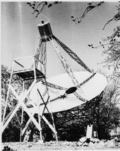Radio astronomy
Radio astronomy is astronomy which studies celestial objects at radio frequencies.
The first detection of radio waves from an astronomical object was made in the 1930s. Karl Jansky found radiation coming from the Milky Way. Later, other sources of radio emission were found. These include stars and galaxies, as well as entirely new classes of objects, such as radio galaxies, quasars, pulsars, and masers.
The discovery of the cosmic microwave background radiation, evidence for the Big Bang theory, was made through radio astronomy.
Radio astronomy is done using large radio antennas. These are called radio telescopes. They are used alone, or with multiple linked telescopes. The use of interferometry allows radio astronomy to achieve high angular resolution.[1] The resolving power of an interferometer is set by the distance between its components, not the size of its components.
Radio Astronomy Media
Karl Jansky and his rotating directional antenna (early 1930s) in Holmdel, New Jersey, the world's first radio telescope, which was used to discover radio emissions from the Milky Way
Grote Reber's Antenna at Wheaton, Illinois, world's first parabolic radio telescope
Chart on which Jocelyn Bell Burnell first recognised evidence of a pulsar, in 1967 (exhibited at Cambridge University Library)
Window of radio waves observable from Earth, on rough plot of Earth's atmospheric absorption and scattering (or opacity) of various wavelengths of electromagnetic radiation
The Atacama Large Millimeter Array (ALMA), many antennas linked together in a radio interferometer
A radio image of the central region of the Milky Way galaxy. The arrow indicates a supernova remnant which is the location of a newly discovered transient, bursting low-frequency radio source GCRT J1745-3009.
Jovian decametric S-bursts (short)
Notes
- ↑ the ability of any image-forming device (an optical or radio telescope, microscope, camera, or eye) to distinguish small details of an object.








